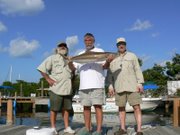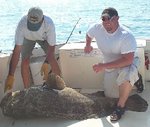Florida Bay Mackerel Fishing
Revised 11/26
Winter Mackerel fishing in the Florida is pretty simple. Get about 8 to 10 miles out in bay in 10 to 12 foot off water, chum like crazy, use wire leaders and catch fish. Okay, I’m done.
Well, maybe there is a little bit more.
If you are in Marathon, 8 to 10 miles north is a good area once they show. If you are in Islamarada, you should head west of Springer Bank. If you are in Big Pine, head north through Spanish Harbor towards the Contents Keys and about three miles further north. You can catch them closer in and further out, this is just the normally productive area.
Pick you area and start chumming. When I’m on the reef, I’ll normally use a larger mesh chum bag. Back in the Bay I use a medium or small mess bag. I want the scent more in the Bay attract mackerel and enough bits to keep the bait fish happy. Once you start chumming you should see a lot of baitfish pretty quickly. Pin fish first normally, then jacks (blue runners and/or Crevalle) and if you are half way lucky, Ballyhoo. All of these can be caught on a small size 6 or 8 hook with a tiny piece of bait, and you should stock your live well.
The Jacks make great shark bait, snip the tail off and balloon them back. They also make great strip bait. Fillet them and cut the fillets in ½ to ¾ inch strips. The ballyhoo is great as live, dead or chunk baits. Use the pinfish as live bait, but if you run low on strips, they work too. I normally take one or two, dozen live shrimp to get things started and a few live crabs, in case something interesting shows up.
I’m not going give away my secret numbers, so I’m sending you guys to a general area. I will go to, well, just a little more special areas. These areas might have a few keeper Grouper, bigger Mangroves, and about a billion times more Cobia, than you’ll see. Other than that it’s the same kind of thing.
You will wire rigs, Mackerel have sharp teeth, you need wire rigs or long shank hooks. I make my on wire rigs, two types for Bay Mackerel. One is very light, size 2, 3407 Mustad, size7 swivel and about 6” of number 2 wire. This is for light currents so the weight of the wire doesn’t take you in the grass. The other is size 2/0 Mustad 3407, size 7 swivel and about six inches of number 4 wire. These are for the bite! I use size seven swivels for two reasons; first the reduce the chance of the bait sliding up the line after a strike – second, if you thread one rig’s hook through another rig’s swivel, you have a stinger rig. If your bait slides up your line, another mackerel will probable cut your line. The stinger rig is great for double hooking ballyhoo. Have a couple dozen of each minimum before you head out. Tying wire rigs with mackerel slime is almost impossible. Use a proper haywire twist on the rigs, meaning don’t cut the tag, twist and break the tag. This is bloodless so you won’t cut your hands on your wire leaders. A snake-er gaff is perfect for handling the mackerel. It has a 1 ½ to 2” gap gaff hook and a long, light fishing pole handle. Make your own, if you like, but they cost less than 20 bucks.
With any Mackerel, a fairly light drag is required with these small hooks. About 3 to 6 pounds is all you want. Set too tight, you’ll have a lot of pulled hooks. The light drag just adds to the fun. Some of the Spanish you can hook are over 10 pounds, lots of fun on light tackle. But bring a little bit heavier stuff for other fish you might encounter.
Once the bite starts, you’ll find that Mackerel love a moving target. Cast your strip baits back in the slick and let them drift a bit. Then jig them a few times and reel them back to the boat. If the Mackerel are way back in the slick, rig up a fairly heavy spoon and cast that back to them. Reel the spoon in fast to tick‘em off and draw them closer to the boat. If they are in the area, you’ll get them going. Throwing spoons the whole time is fun, but costly. You will lose a lot of lures if you catch a good bite. Spanish aren’t the sharpest tacks in the box when they strike, they will miss short and miss long, and snip your lure off. I’ve seen a dozen Spanish miss a spoon on one cast. It’s pretty comical.
If you like fly-fishing, a fairly large, Clouser-minnow, yellow or blue and white or Hell Just Put One In The Slick, it will work quite well. Remember to use a few inches wire leader. Tie the fly to the wire using a haywire twist and the fly to a mono shock leader with a dog knot If you don’t know a dog knot, use a Albright knot. Same deal as with the strip baits. Cast out, let it drift a little, twitch a little, then strip fast a few times. If you don’t hook up, repeat until you do. A nine-weight fly rod is recommended, just because of the wind you’ll probably be fighting. When you hook up a big one, get ready for some great runs.
Other critters that may show are Cobia, Sharks, Snapper, Grouper, Seatrout, Pompino, Permit, Ladyfish, Bluefish, Cero Mackerel, King Mackerel, Tarpon and Goliath Grouper. Other than that it’s pretty much just Spanish Mackerel you will encounter. I mentioned that I take a few crabs for interesting fish. I think Permit and Cobia are kind of interesting. Oh, those live pinfish drifted back, can get nailed pretty hard, as will as live or dead ballyhoo.
If you get some big spinner sharks it’s a blast. You will need a special leader set up or heavier tackle to bring one to the boat. First, you will need a super strong hook. A 4/0 to 7/0 super strong works great. Second, two or more feet of number six or heavier wire. Third, enough 60 to 80 pound mono, to complete your 20 foot total length leader for less that 30 pound main line or 25 feet for 30 pound and heavier. Finally, 10 feet of double line for less than 30 pound main line or 15 feet for 30 and heavier. Why, because these fish spin like a top when they jump, wrapping a lot of the leader around them. As the Spinners twist and turn, they will stress the heck out of your rig. I’ve hooked spinners that would push a buck-fifty plenty of times and lost a few they might have hit 200 pounds. I normally balloon one of these rigs way back in the slick.
Best Months: January through March
Tight Lines






No comments:
Post a Comment